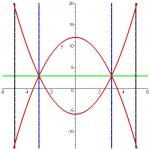SeekerOfDragons
New member
- Joined
- Oct 8, 2009
- Messages
- 46
I'm having some trouble setting up and solving the following problem:
Find the volume of the solid formed by revolving the region between the curves y = 12 - X^2 and y = X^2 - 6 about the line X = 5 from [-5, 5]
There are 3 regions that will have an area between the two curves. will that mean I need to perform 3 calculations and add them together? such as calculate using the washer method the area from -5 to -3, then from -3 to 3, and finally from 3 to 5?
I'm just about totally lost on how to set up this problem since there are 3 different areas that will have a volume and rotating it about X=5 is throwing me off a bit too.
any advice on getting started and solving would be greatly appreciated.
Find the volume of the solid formed by revolving the region between the curves y = 12 - X^2 and y = X^2 - 6 about the line X = 5 from [-5, 5]
There are 3 regions that will have an area between the two curves. will that mean I need to perform 3 calculations and add them together? such as calculate using the washer method the area from -5 to -3, then from -3 to 3, and finally from 3 to 5?
I'm just about totally lost on how to set up this problem since there are 3 different areas that will have a volume and rotating it about X=5 is throwing me off a bit too.
any advice on getting started and solving would be greatly appreciated.



